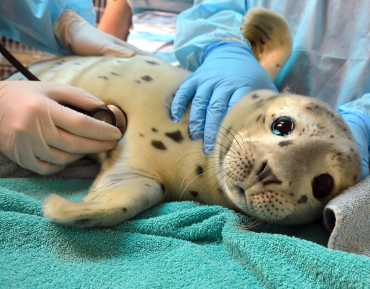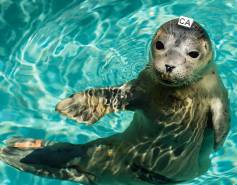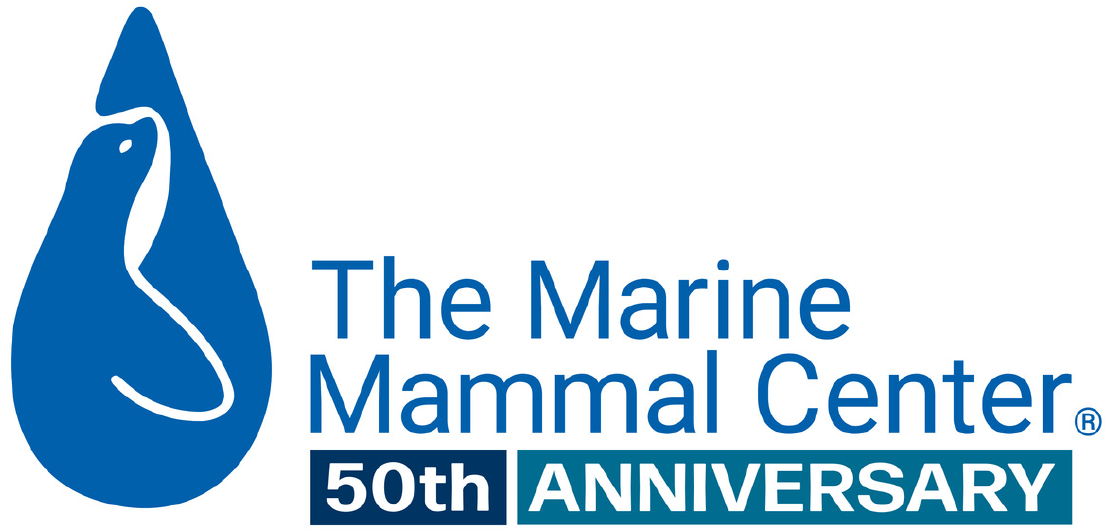
What it Takes to Rescue an Entangled Sea Lion
- Entanglement
- Ocean trash
Experts at The Marine Mammal Center developed an innovative technique to more safely and effectively rescue entangled marine mammals from challenging locations. Read about the behind-the-scenes work that went into California sea lion Pinger’s rescue mission, why high-risk rescues depend on days of crucial coordination, and why it’s important to call the experts instead of approaching a marine mammal.
Rescuing California Sea Lion Pinger
On a bright and sunny morning at PIER 39 in San Francisco, the docks were packed with California sea lions. They barked and jostled for position, providing an entertaining spectacle for gathered onlookers. That is until one animal on the edge of a floating platform lifted his head and revealed rings of ocean trash wrapped tightly around his neck.
Caring people like you called The Marine Mammal Center’s response hotline to report this sea lion in distress. Named Pinger, he had sadly been entangled in ocean trash for a while. He was first spotted with the entanglement about two years earlier, and the wounds appeared more severe each time he was reported. Thankfully, each person who called our hotline provided our experts with vital information to help track and rescue this animal.
Sometimes, a marine mammal may be in good body condition but suffering from an injury or entanglement that can take weeks to even months or years of tracking before rescue. Intervention was critical to save Pinger’s life, and after years of him swimming off before responders could get to him, the Center launched the rescue mission.
The Center is a leading first responder to marine mammals in distress, and our experts are specially trained in responding to sea lions, seals, sea otters and more in a variety of locations from beaches to docks to rocky shores. When an animal like Pinger cannot be reached safely by land or it is surrounded by other animals, we may launch what is called a “special rescue operation” that requires additional planning and coordination.
For high-risk rescues like Pinger’s, special rescue operations can include using an innovative dart we designed that sedates the entangled animal and has an acoustic tracking device. The Center works closely with our partners at the National Oceanic and Atmospheric Administration (NOAA) to coordinate these rescues and requires approval from the agency when sedatives are used on marine mammals outside our hospital facility.
While a special rescue operation like Pinger’s can take days to coordinate in advance, our planning process is crucial to ensure the animal’s best chance at survival and the safety of animals and people. There’s a lot at risk when working with wild animals, which is why these safety measures must be taken at every step of the rescue.
Even if well-intentioned, members of the public getting too close to marine mammals can cause extreme stress and further harm to the sick or injured animal, surrounding animals, and people. Attempts to disentangle an animal without expert training can sadly make the situation more dire, potentially worsening the entanglement or injuring the animal by using inappropriate cutting tools and techniques. Deeply embedded entanglements also require expert veterinary care to assess any internal damage and prevent infection.
If you see a marine mammal in distress, even for multiple days, it’s important to call our experts and keep a safe distance.

After crucial days of planning and behind-the-scenes work, Pinger’s rescue mission was underway at PIER 39. Our team launched a boat and slowly circled the docks while keeping a distance, taking every precaution to not disturb the other sea lions resting nearby. Voices were hushed and motions were methodical, as any loud noise or sudden movement could result in a human-caused stampede of sea lions into the water, thwarting the rescue as well as causing stress to the surrounding animals.
From the softly swaying boat, Dr. Cara Field, the Center’s veterinary expert who is highly trained in this specialized rescue technique, launched the acoustic dart squarely on Pinger’s shoulder. Through five decades of veterinary expertise, the Center has honed the medical dosage of sedatives to deliver the safest possible outcome of anesthesia. Our innovative rescue technique allows the sea lion to be sedated enough to not be a danger to the rescue team, but it will still rise to the ocean surface to take a breath whenever it needs one.
After Pinger dove off the dock with the dart still attached, sounds from the dart’s tracking device reverberated through the water. From a second boat circling the dock, our trained expert held a hydrophone (an underwater microphone) into the water. A series of acoustic “pings” were detected by the hydrophone, guiding the team to Pinger’s location to safely net him from the water (you can see how Pinger got his name!).
Following this successful rescue, Pinger was transported to our hospital in Sausalito, California for state-of-the-art medical care. Our veterinary experts administered anesthesia and used specialized tools to safely remove the netting that was embedded deeply into Pinger’s neck. The entanglement material was then sent to NOAA for data collection, helping us better understand the impact of ocean trash and protect marine mammals.
Animal care experts cleaned Pinger’s wounds, provided antibiotics and monitored him for signs of infection to ensure he could thrive in the wild. Thanks to support from people like you, this sea lion received a clean bill of health and returned to his ocean home in a matter of days. The very next day after his release, he was spotted back at PIER 39 resting alongside other sea lions. This time around, Pinger was healthy, healing and free of ocean trash.
Behind-the-Scenes Work Before the Rescue
Before a special rescue operation like Pinger’s can begin, our experts coordinate extensively behind the scenes to ensure the safety of the animal and our trained responders and the best chance at a successful rescue.
Receiving the call
Every rescue begins with a sighting. When a caring person like you calls our hotline to report a marine mammal in distress, our response dispatchers gather as much information about the animal as possible and thoroughly document it in our database to inform the potential response.
For an entangled animal in a crowded location like PIER 39, our dispatch office can often receive several dozen reports in a single day for the same animal. This high volume of calls helps our responders get plenty of information about the distressed animal.
Responding to the animal
The Center’s number one priority is human and animal safety. Our trained responders are dispatched if appropriate to assess the situation and rescue the animal when needed. We take special precautions to limit the disturbance and stress of other nearby animals and only proceed with a rescue if it is safe for the reported animal, surrounding animals and people.
If an entangled animal can be rescued from land without having to use sedatives, hydrophones, boats and all the coordination that comes with a special rescue operation, the time between response and rescue can be faster. However, in a high-risk situation like Pinger’s, additional steps are crucial to give the animal its best chance at surviving.
Monitoring the animal
A monitoring period can be a critical next step to ensure safety measures are taken and that our action plan is successfully coordinated for the animal and location.
Trained volunteers may be sent to continue assessing the animal, the severity of its entanglement, and the location and whether it is accessible. We also monitor the animal’s behavior to determine when it is most likely to haul out, or temporarily leave the water, which is when it can be rescued. Calls to our response hotline during this time help our experts monitor the animal and gain additional information needed to create an action plan.
Outlining the action plan
If an appropriate amount of time goes by to determine that the animal is sticking around in the same location, the next step is to outline the potential special rescue operation. This document meticulously details all the information about the distressed animal, its location, a schedule of the operational steps, each team member and their role, and any potential contingencies like unexpected weather or people at the location.
Coordinating with NOAA
Once the plan for the special rescue operation is drafted, it is sent to NOAA for approval to ensure there are no potential hazards to human or animal safety and that the plan complies with the regulations of the Marine Mammal Protection Act.
Working with law enforcement and other partners
Since our specialized dart projector can at first glance be mistaken for a firearm by someone unfamiliar with this rescue technique, we also coordinate with local law enforcement in case a well-meaning person calls 911. For special rescue operations at crowded locations like PIER 39, location representatives sign off on the planned date and time and often provide invaluable personnel and resource support.
Launching the rescue mission
Our experts undergo extensive training leading up to a rescue like Pinger’s, from understanding animal behaviors and clinical health to operating our specialized tools and technologies. Ready to begin the rescue mission, our highly trained team assembles at the entangled animal’s location and launches the boat equipped with the acoustic dart, hydrophone and other rescue tools.
Thanks to caring people like you, the Center’s darting technique is at the forefront of innovation in marine mammal rescue. As we share our expertise, technology and experience with partners around the world, your support is having a ripple effect to save more entangled animals like Pinger on a global scale.
Yes, I want to save a life!

Yes, I want to save a life!
You’ll be giving sick and injured animals the best possible care at the Center’s state-of-the-art hospital. With your gift today, you are giving a patient a second chance at life in the wild.
See Our Latest News
{"image":"\/Animals\/Patients\/Harbor seals\/2020\/cropped-images\/hs-barnwood-by-bill-hunnewell-c-the-marine-mammal-center-315-0-3299-2577-1607370547.jpg","alt":"harbor seal Barnwood","title":"Last-Minute Gift Guide \u2013 Top Gifts that Give Back to Marine Animals","link_url":"https:\/\/www.marinemammalcenter.org\/news\/last-minute-gift-guide","label":"News Update","date":"2025-12-18 01:00:00"}

Last-Minute Gift Guide – Top Gifts that Give Back to Marine Animals
December 18, 2025
Read More{"image":"\/Animals\/Patients\/Hawaiian monk seals\/2025\/cropped-images\/b-ru72admission-to-ke-kai-ola112125photo-c-the-marine-mammal-center-noaa-permit-24359-0-364-1270-992-1766095407.jpg","alt":"A newborn Hawaiian monk seal pup with a black coat in rehabilitative care.","title":"Newborn Hawaiian Monk Seal Pup Now Receiving Care","link_url":"https:\/\/www.marinemammalcenter.org\/news\/newborn-hawaiian-monk-seal-pup-now-receiving-care","label":"Patient Update","date":"2025-12-18 01:00:00"}

{"image":"\/Animals\/Patients\/Hawaiian monk seals\/2025\/cropped-images\/d-ru28release-exam-at-ke-kai-ola111025photo-by-giancarlo-rulli-c-the-marine-mammal-center-noaa-permit-24359-0-0-1270-992-1764620886.jpg","alt":"","title":"Bird Flu Vaccine Trial Offers Hope for Protecting Hawaiian Monk Seals","link_url":"https:\/\/www.marinemammalcenter.org\/news\/bird-flu-vaccine-trial-may-offer-hope-for-protecting-hawaiian-monk-seals","label":"News Update","date":"2025-12-01 08:13:00"}

Bird Flu Vaccine Trial Offers Hope for Protecting Hawaiian Monk Seals
December 1, 2025
Read More{"image":"\/Animals\/Patients\/Hawaiian monk seals\/2021\/hms-pp08-by-sheila-latta-c-the-marine-mammal-center-noaa-permit-18786.jpg","alt":"Hawaiian monk seal","title":"The New York Times: Inside the Bird-Flu Vaccine Trial for Monk Seals","link_url":"https:\/\/www.marinemammalcenter.org\/news\/the-new-york-times-inside-the-bird-flu-vaccine-trial-for-monk-seals","label":"In the News","date":"2025-12-01 01:00:00"}

The New York Times: Inside the Bird-Flu Vaccine Trial for Monk Seals
December 1, 2025
Read More











